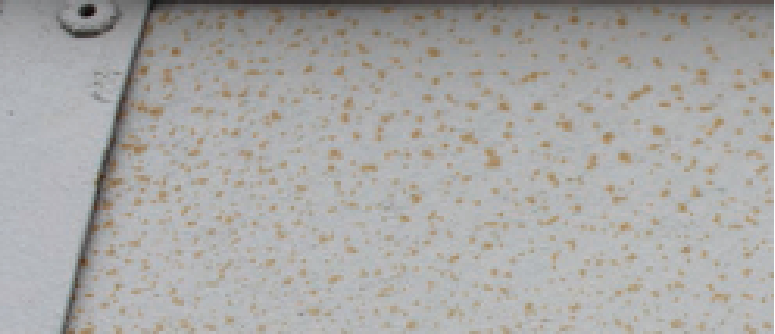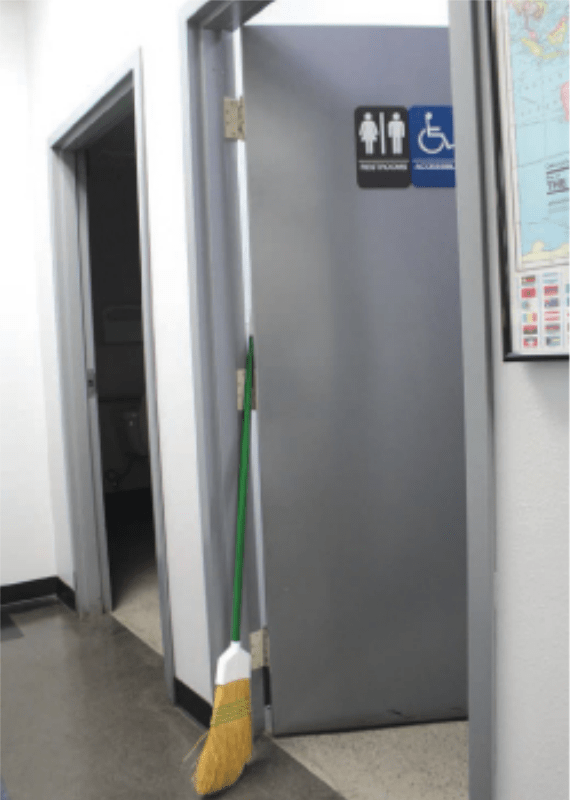Damaged Steel Doors: Repair or Replace?
At this very moment, hospital doors are being assaulted by fast-moving gurneys, backpack-wielding kids are jump kicking an exit device in their haste to leave campus, and cleaning crews are wedging a broom handle between the door and frame to prop them open.
Buying new doors can really put a dent in a facility manager’s budget. Fortunately, damaged steel doors can often be repaired rather than replaced. But not all repairs make financial sense – if your maintenance person would have to spend 4 hours on a repair, it may be better just to purchase a new door.
Here are a few guidelines to help you determine whether a door in your facility should be repaired or replaced.
Diagnosis: Replace
A properly set steel frame undergoing normal use will stand the test of time. However, there are certain circumstances you should look for in regards to the opening.
Door Frame No Longer Square
When you have an older building and the frame is no longer plumb, level and square, you are better off replacing the door and frame. If you were to just replace the door and keep the existing frame you could leave yourself open to issues such as undue stress on hinges (called “hinge bind”), improper clearances for fire rated openings, and improperly fitting and operating hardware.
Compromised Core
Back to the hospital example, if a gurney or crash cart repeatedly slams into a steel door, it can damage the door enough to harm the core. No matter the cause, once the core is compromised it jeopardizes the integrity of the door and the door must be replaced.
Delamination
Another situation in which you’ll need to replace the door is if it is showing signs of delamination — perhaps due to water damage or harsh environments. Once a door is flimsy and has lost its rigidity it should be replaced. You can test this by trying to twist the door vertically by setting your foot at the base of the door on the lock stile side and attempt to pull the top of the door towards you. If it moves greater than 1/4 – 3/8 of an inch, there is a good chance your core is delaminated.
Rust Damage
Rust generally starts inside the door. So once you see rust on the exterior of the door, the core has been compromised — it’s too late, the door will need to be replaced.
If your door’s demise is due to rust, you should consider replacing it with a galvanneal coated door. This iron-zinc coating prevents corrosion by acting as a barrier between the steel and moisture. The galvanneal coating in today’s doors are on the outside AND inside of the door, greatly increasing the life cycle of the door in regards to rust intrusion.

Rust generally forms on a door from the inside out.
Once you see rust, the core is already compromised.
Vandalism
Doors subjected to vandalism or forced entry typically need to be replaced; that kind of force often leads to a compromised core, damaged edges, and more. It very well may also affect the door frame, given the amount of pressure required to force open a locked steel door. When repairing due to vandalism or forced entry, be careful to review all areas of the opening, not just the area of compromise.
Can the Opening be Improved?
Remember the old expression, insanity is doing the same thing over and over again and expecting different results? Rather than replacing your doors with the exact same product, consider if another door would be better suited for that opening. In instances of vandalism or abuse, perhaps a heavier gauge steel door should be purchased instead. While the upfront cost may be higher, the ROI of the door may be better because it will last so much longer.
Since you are spending the time to read this article, you likely keep your facilities up-to-date in an effective and cost-efficient manner. Replacing doors gives you an opportunity to do just that. You’ll want to ask yourself, “Is this the optimum door assembly for this opening?” For example, openings in hospitals and businesses frequently require badges to move throughout the building. Due to the expense of electronic locks, they are often only added to select doors at first while the remainder stay with their existing manual locks. This is inconvenient to those that must carry badges and a set of keys. If doors and hardware with manual locks have to be replaced, it presents a great opportunity to upgrade to electronic locks while you’re at it.
Diagnosis: Repair
A major benefit of steel doors is their re-workability — they can be welded, ground and patched. This means that repairs can often be made relatively inexpensively and usually in the field. Here are a few instances in which you can save money by repairing the door instead of replacing it.
Hinge Damage
Earlier we referenced cleaning crews jamming a broomstick or mop handle into the door to prop it open. That places a lot of stress on the top hinge and can eventually compromise or even break the weld points of the hinge reinforcements. This results in a sagging, improperly gapped door, or worse yet, an inoperable opening.
The first thing you should do is let the cleaners know you have a “no broom sticks as door stops” rule. Then with the help of some basic welding skills, the door can be repaired in about an hour by doing the following*:
- Remove the door and the hinge attached to the reinforcement
- Drill welding holes in the area where the hinge reinforcement sits
- Clamp or hold the hinge reinforcement in the original place and plug weld
- Grind smooth, prime, paint and rehang
*Be sure to check with local jurisdiction when repairing or reworking fire labeled openings that the repairs will not jeopardize the underwriting.
Patching Holes
One of the nicest things about steel, besides its sturdiness and longevity, is that if the door is impacted in a way that causes a hole to develop, because steel is so pliable, you may easily weld a patch over the hole in the door. Be sure to pay attention to any fire rated concerns and procedures in regards to patching or filling holes, and always defer to your local authority having jurisdiction or NFPA.
Dents
When the damage is just a dent and hasn’t penetrated through the outer layer of the door, you can apply bondo, sand and paint the door. More often than not, no one will be able to tell that it’s been repaired.

Other Types of Doors
The repair options listed above are largely unavailable with wood, aluminum and fiberglass doors. When subject to extreme force, fiberglass will shatter rather than dent. Aluminum has a higher tensile surface strength so that it’s very difficult to repair in the workshop, let alone out in the field. On a wood door, if the veneer is damaged down to the substrate it too cannot be repaired.
Fortunately, most steel door repairs can be performed in the field with basic equipment and expertise. Keep that in mind the next time you see a kid jump kick your door, you may just cringe a little less.

